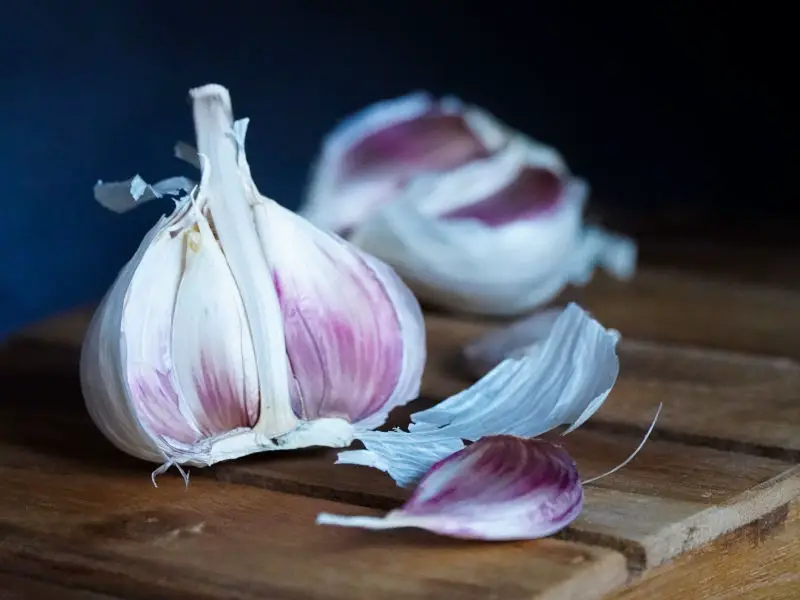Planting garlic in Australia has become the smart thing to do following the local shortage created by the 2022 floods. Garlic is quite easy to grow and will do well in a variety of climates. Here we cover the important factors you should consider when choosing and planting garlic in Victoria, SA, NSW and Tasmania.
It’s expensive to buy Australian garlic, so it makes sense to try growing it yourself. With so many cultivars [a cultivated plant variety] available, it can be difficult know where to start. Start here!
Availability
To make things easy, start with what’s available. Some years, there won’t be a lot of varieties available, such as in 2023 after the floods of 2022. Consider:
- Supplier location – nurseries, garden centres, Bunnings etc or online. Online will offer the biggest choice and may be able to answer specific questions about suitability for growing conditions in your area.
- Planting and harvesting times – don’t forget to work around any planned holidays!
- Quantity. How much do you need?
Position, Climate and Soil
Postition: Garlic likes a position in full sun. This is in the top 3 most important factors for success. Garlic can also be planted in pots which gives you some flexibility to move them around and chase the sun.
Climate: This is variety dependant; some thrive in a cool, dry climate, others are adapted to heat and or humidity.
Soil: well-drained soil with a pH between 6.0 and 7.0.
It is important to choose a garlic variety that is suited to the local climate and soil conditions. Check the planting guide for each variety.
How important is variety when planting garlic in Victoria, SA, NSW and Tasmania?
When choosing garlic for planting, it is super important to select a variety (cultivar) that can thrive in your local climate. There are dozens of garlic cultivars available in Australia and elsewhere, each with its own unique flavour and characteristics. Cultivars have varying levels of tolerance to different climatic conditions. For example, some are better suited for hot, dry summers, while others can tolerate colder temperatures or more rainfall. Consider your local factors such as:
- average temperature and overnight temperatures
- average spring and summer rainfall and access to irrigation
- humidity
Hedge your bets and select multiple varieties of garlic
If you’re new to growing garlic, it can be a good idea to grow 2-3 cultivars to get proof of what works best in your soil and climate. Try a softneck and a hardneck.
Consider also the cultivar’s flavour, bulb and clove size, and storage qualities. Some popular garlic cultivars for South-Eastern Australia include Italian Late, Spanish Rojo, Italian Purple, Ail de Pays de Gers, Australian White, Camino and Tasmanian Purple.
How does bulb size and quality affect garlic growth?
When selecting garlic bulbs for planting, size is easy: the larger the garlic clove, the larger the resulting bulbs will be. Quality is more complicated. For best quality, choose bulbs that are:
- firm: any cloves that are slightly soft or bendy have begun to dry out and will not grow well.
- plump: aim to plant the largest cloves from the largest bulbs. Typically, these are the cloves on the bulb’s outer ring of cloves.
- free of disease: inspect bulbs carefully before planting, ensuring there’s no mould or black spots. It’s not always possible to tell if a bulb is carrying disease, but do avoid planting obviously compromised bulbs.
- from a reliable supplier: choose an established supplier and preferably one that is local to your planting site so that the garlic has been grown in similar climate and conditions. Certainly some garlic varieties can adapt to different conditions, but this can take a few seasons. Avoid planting bulbs from the supermarket as they are highly likely to have been sprayed for disease or to prevent sprouting. Supermarkets also rarely identify the variety of their garlic. Seek information from suppliers about growing conditions for your favoured varieties.
Garlic Planting and Care
The Australian garlic season is typically:
- plant in autumn (mid-March to May), but some cultivars can be planted as late as July-August
- harvest in late spring or early summer (October to December), but January in colder climes. It does depend on the cultivar (variety).
5 Tips for Planting Garlic
Garlic should be planted in well-drained soil with plenty of organic matter such as compost and sheep manure. It is important to
- Plant cloves with the pointed end facing up, about 5-10cm deep and 15-20cm apart.
- Add a layer of mulch to prevent weeds.
- Water and weed regularly.
- Fertilise monthly, especially during the growing season.
- Keep the soil moist but not waterlogged.
See our full guide to growing garlic (coming soon).
Harvesting
Harvest garlic by lifting it from underneath with a garden fork. Depending on your soil type, and how much garlic you have planted, this can be hard work! Be careful not to pull the stems before loosening them from the soil as they can break off.
Garlic is typically ready to harvest when the leaves start to turn yellow and dry out. Often this is when there are 4-5 green leaves remaining. It is important to harvest garlic before the leaves completely dry out to ensure the best quality bulbs. Also check the cloves are well defined so that you can feel the bumps between them.
Curing/Drying
After harvesting, garlic needs to be cured in a dry and well-ventilated place for 3-12 weeks (depending on your climate). They key is having good ventilation around each bulb. Ways to dry garlic include:
- tie garlic in bunches and hang in your well ventilated shed
- lay them in a single layer on a table or in stackable bread crates
Cleaning and Storage
Once dry, trim the stems and the roots if you haven’t already, with some secateurs. Brush off any dirt – this may involve removing the outer 1-2 layers of paper if you plan to make them look nice for sharing with friends or family. Some soil types will stain the outer layers of paper a greyish colour – this is fine but you might prefer to remove it if sharing.
Store cured garlic in a cool, dry place – see our guide to storing garlic for optimal shelf life. Consider also preserving some garlic to ensure you have enough for the year.
With a little bit of research and planning (and a little bit of luck with the weather), you too can have a successful Australian garlic crop.
EXPRESS DELIVERY AVAILABLE
Order Online
Our fresh Australian garlic is sold by weight, in plaits, or in gift or variety boxes. We grow several varieties including pink, purple stripe, Spanish Rojo and Italian Late, as well as golden shallots.
Garlic Planting Packs
Our 3-bulb garlic planting packs are available in several hardneck varieties. Plant in April-May-June and harvest in December.

Planting garlic in Australia has become the smart thing to do following the local shortage created by the 2022 floods. Garlic is quite
Naturally grown garlic vs conventionally grown. Here we explain why we think naturally grown is a better alternative to garlic grown in other ways.
Storing fresh garlic for longest shelf-life. What is the best way to store garlic so you can use every last clove? We explain what works best.





